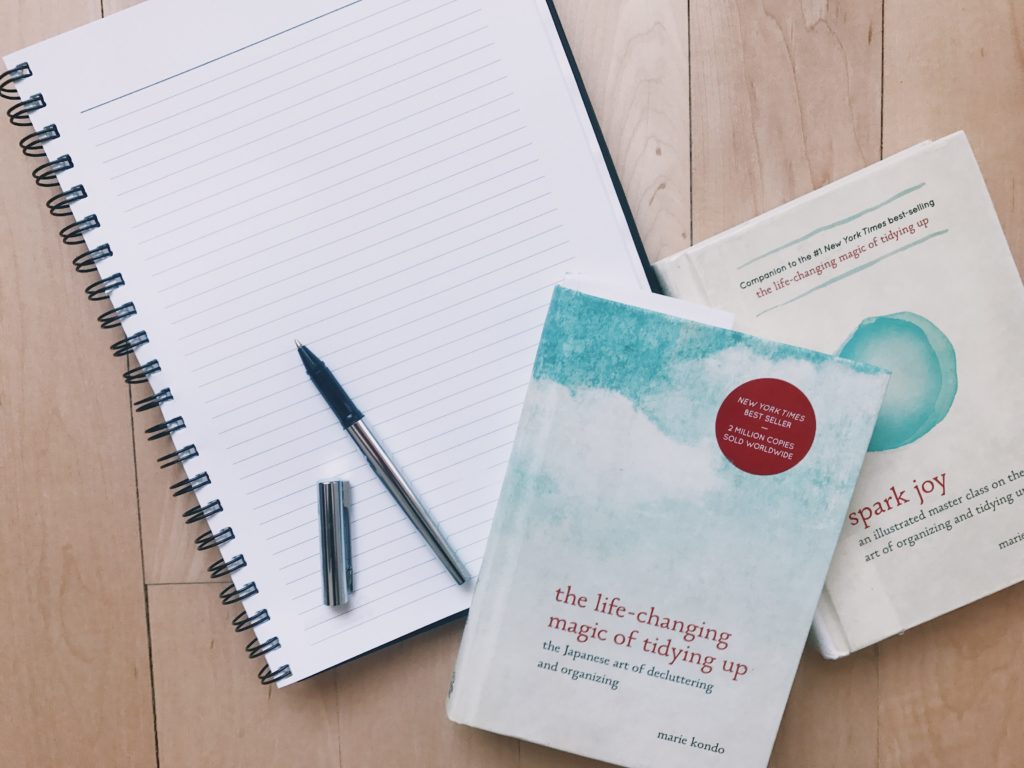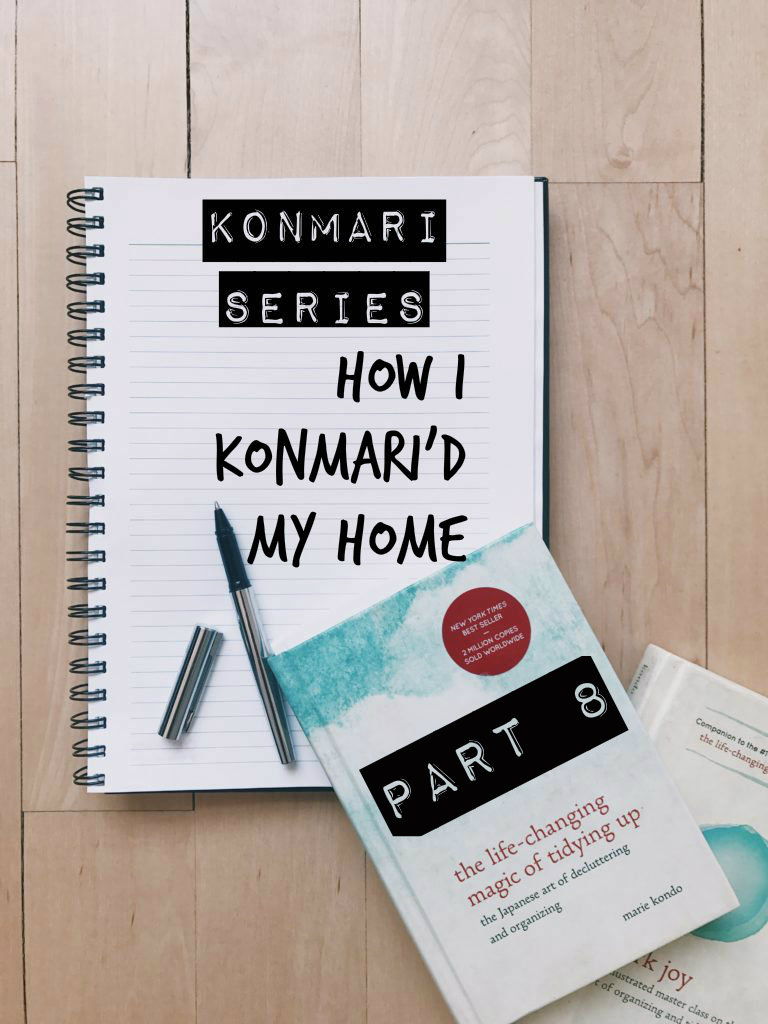This post is part of the KonMari Series in which I document my journey to becoming a certified KonMari organizing consultant. Start from the beginning here and/or see all posts of the series here.
Today, I’m writing about my own KonMari home project.
Important: Don’t Let Anyone See It
As I already mentioned previously, I’m a pretty organized person and don’t own too much stuff. However, I knew that I could still size down and that the KonMari Method would help me achieve that once and for all.
My goal was to work on all the five categories in the recommended order and get through everything as quickly as possible. I started on a day when my husband was out of town. This was on purpose because I didn’t want him to see what I would eventually get rid of. The reason is that he likes to pick something up and argue with me that I possibly can’t let go of it because
- It was expensive,
- It can still be used,
- One of his family members at home in Europe could use it and he wants to send it home (happens frequently),
- “Just because.”
Life as a minimalist is hard if you have to live with a hoarder (jk).
Day 1: Clothing
Although I hesitated at first, I got everything out of every single closet and put it on the floor or on my bed. I went through it pretty quickly. I put all the clothes I wanted to keep on one side of the room, roughly divided by sub-categories. The items I wanted to get rid of, I divided into “donate”, “sell” and “discard” piles.
Before starting, I had decided that I would deal with the actual getting rid of things part after completing all five categories. That meant that I had to determine one part of our apartment as temporary storage for all those items. So I put the three bags with clothes to donate and sell in that corner. The clothes I wanted to discard, I discarded immediately.
Now the fun part began where I had to figure out where I wanted to store all my clothes, fold them KonMari style and put them in their new (or old) home. Shoes went back into the shoe closet which we custom-built not too long ago and which I love. I continued with the clothes to hang and heavier sweaters which went on the top shelves of my closet. I continued with folding everything else and figured out storage along the way.
In the end, I was able to fit all my jackets, coats and other hanging clothes into one closet. Previously, jackets and coats were located in a separate closet near the entrance. Otherwise, I was able to free up two shelves in the shelves-portion of my closet and I was able to fit all my underwear, socks and foldable tops into one drawer.
The amount of space freed up by folding was astounding to me. And I was delighted at the fact that everything looked pretty neat and easily accessible. Especially my socks and underwear, which I placed into the lids of shoe boxes.
Day 2: Books and Papers
Discarding books was rather easy for me. I’ve never been one to accumulate books. The library is my best friend. I know, old school. So many people I know laugh at me when I tell them I borrow all my books from the library. Well, to each their own. For me, I only see advantages in borrowing books from the library. But let’s not talk about the library here (you see, I’m pretty passionate about it).
So I only had three books or so. I decided to keep one. A Fashion dictionary in which you can look up every possible term for different clothing and parts of clothing. I found it at a thrift store and it came in handy at one of my former jobs. But, I digress again.
I hesitated with letting go of two books about thyroid conditions. But I remembered Marie Kondo saying that you should aspire to only surround yourself with book titles that represent the person you want to be(come), so I let them go.
On to papers. While I was done with books in mere minutes, papers took the rest of my day. I dedicated one box for papers and other things to deal with from the outgo. Most all of my papers were in binders. Some of them were mixed in with my husband’s papers. I went through everything and separated mine from my husband’s papers as a first step.
As a second step, I went through all my papers and took everything out of the binders I wanted to get rid of. Further, I divided those papers into a “to recycle” and a “to shred” pile. I took care of the recycling immediately and added the bag of papers that needed to be shredded to the other things I needed to deal with after completion.
I divided the papers I kept into the following:
- Box with papers I need to deal with
- Binder with payslips (I don’t want to get rid of them because they help me prove my earnings and thus help me claim retirement benefits later in life)
- Binder with both papers I need and want to keep indefinitely and temporarily, such as insurance policies, certificates, bank statements and medical records.
Day 3: Komono (Except Kitchen Komono)
With komono, I started out by writing down all the different sub-categories Kondo lists in “Spark Joy”. I added (e.g., supplements, travel komono, grocery bags) and removed (e.g., stuffed toys) sub-categories as I went along. Then, I put all of the komono items (except kitchen stuff) on the floor. Next, I tackled sub-category by sub-category.
It took me almost an entire day to complete this part of my work. Although it wasn’t too hard to decide what to keep, the fact that the sub-categories are quite a few eats up time. Also, I spent a good portion of that time deciding where everything should go and how I wanted it to be stored.
Day 4: Kitchen Komono
On the next day, I set out to tackle kitchen komono. With the exception of our main dish set (which is located on an Ikea shelf that serves as a room divider), I took everything off the shelves and out of drawers and cupboards and gathered it on the floor of the kitchen.
My main problem consisted in that most of the kitchen items belong to me and my husband jointly. I sorted through everything and put the items that I would have discarded, but couldn’t without the consent of my spouse, into a separate box. After I was done with everything, I asked him to look through this box and tell me what he wanted to keep. The ones he wanted to keep went back in the cupboards/on the shelves.
It prooved tremendously helpful having removed all the kitchen komono from all their storage places. Almost everything found a new home. It took me a while to figure out the best solution where to store things (and I still need to tweak a few things), but it was definitely worth the time and effort and I’m very pleased with the result.
In terms of food, I didn’t have to go through a lot of stuff. We mostly buy fresh foods that is stored in the fridge as well as two fruit baskets. Other things like rice, lentils, oats and the like, we store in glass identical containers on floating shelves. Then there are three drawers with canned items, spices etc. Vinegar and a few other bottles with liquids and oils are stored separately in a cupboard.
Day 5: Mementos
The sentimental category was rather easy for me. I’ve gotten rid of many things like postcards, greeting cards and journals over the years already. Moving a couple times also helped with that. So I only had to tackle a stack of photos that weren’t in albums and a few letters I struggled with. These are the things I kept:
- 4 photo albums
- 1 small stack of photos (already sorted, still need to put in album)
- 1 drawing book and 1 folder of my drawings I did when I was a child
- 4 year books (with photos and stories and contact info of fellow students)
- 1 newspaper clipping with a photo of me and report about my achievements as an athlete when I was a child
Now that I completed my own KonMari home project, I was ready to attend the seminar. In my next post of this series, I will tell you all about my KonMari seminar experience in Los Angeles!
PIN IT:


